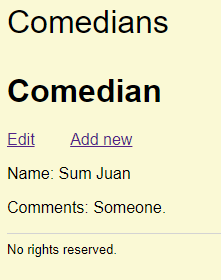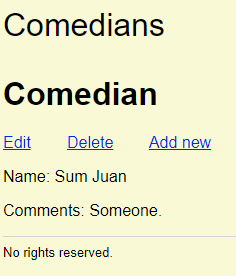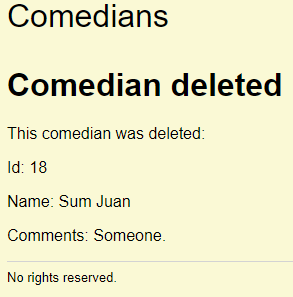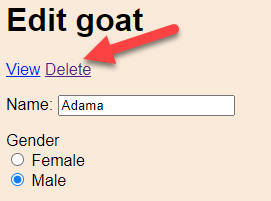We know how to let users view records, change records, and create records. Just one operation left: delete.
Requirements
Let's start by working out what we want users to see. We made a view page like this:

Let's add a delete link:

Here's the HTML to make the links:
- "<p class='operations-container'>
- <a href='add-edit-comedian-form.php?comedian_id={$comedianId}'>Edit</a>
- <a href='confirm-delete-comedian.php?comedian_id={$comedianId}'>Delete</a>
- <a href='add-edit-comedian-form.php'>Add new</a>
- </p>\n";
Let's think about this. When the user hits Delete, what should happen?
When the user hits Delete, what should happen?

Adela
Don't just delete. Make sure the user didn't click it by accident.
Right! Something like this:

If the user clicks delete:

This gives us a new principle:
People make mistakes. If there's a destructive action, like deleting a record, then confirm it with users.
One approach is the delete conformation page, as in the famous goats app. There's a delete link on each edit page.

Click it, and the app asks you to confirm. It shows you the thing you would delete, too, so you can check it's the right one.

It's easy to get into the habit of confirming everything, though. Another approach is to ask the user to type something about the thing to be deleted. That's what Github does. When you delete a repo, it asks you type the name of the repo as confirmation.
First step
Here's the delete link on the view page:
- <a href='confirm-delete-comedian.php?comedian_id={$comedianId}'>Delete</a>
This link passes the comedian id. Here's confirm-delete-comedian.php:
- <?php
- // Connect to the database.
- require_once 'library/useful-stuff.php';
- $errorMessage = '';
- $comedianId = getParamFromGet('comedian_id');
- $errorMessage = checkComedianId($comedianId);
- if ($errorMessage == '') {
- $comedianEntity = getComedianWithId($comedianId);
- if (is_null($comedianEntity)) {
- $errorMessage = "Sorry, there was a problem loading comedian with id $comedianId.";
- }
- else {
- $comedianName = $comedianEntity['name'];
- $comedianComments = $comedianEntity['comments'];
- }
- }
- ?><!doctype html>
- <html lang="en">
- <head>
- <?php
- $pageTitle = 'Confirm delete';
- require_once 'library/page-components/head.php';
- ?>
- </head>
- <body>
- <div class="container">
- <?php
- require_once 'library/page-components/top.php'
- ?>
- <h1>Comedian</h1>
- <?php
- if ($errorMessage != '') {
- print "<p class='error-message'>$errorMessage</p>";
- }
- else {
- ?>
- <p>Are you sure you want to delete this comedian?</p>
- <p>Id: <?php print $comedianId; ?></p>
- <p>Name: <?php print $comedianName; ?></p>
- <p>Comments: <?php print $comedianComments; ?></p>
- <p class='operations-container'>
- <a href='delete-comedian.php?comedian_id=<?php print $comedianId; ?>'>Delete</a>
- <a href='view-comedian.php?comedian_id=<?php print $comedianId; ?>'>Forghedaboudit</a>
- </p>
- <?php
- }
- require_once 'library/page-components/footer.php';
- ?>
- </body>
- </html>
It's mostly the same as the view page. The operation links are different:
- <p class='operations-container'>
- <a href='delete-comedian.php?comedian_id=<?php print $comedianId; ?>'>Delete</a>
- <a href='view-comedian.php?comedian_id=<?php print $comedianId; ?>'>Forghedaboudit</a>
- </p>
The first one goes through with the delete. The Forghedaboudit link jumps back to the view page.
Doing the delete
We could run the DELETE and jump to another page, but instead, we'll let the user know what happened.

Here's the PHP that deletes the record, and makes the display.
- <?php
- // Connect to the database.
- require_once 'library/useful-stuff.php';
- $errorMessage = '';
- $comedianId = getParamFromGet('comedian_id');
- $errorMessage = checkComedianId($comedianId);
- if ($errorMessage == '') {
- $comedianEntity = getComedianWithId($comedianId);
- if (is_null($comedianEntity)) {
- $errorMessage = "Sorry, there was a problem loading comedian with id $comedianId.";
- }
- else {
- // Put the field values into variables.
- $comedianName = $comedianEntity['name'];
- $comedianComments = $comedianEntity['comments'];
- // Delete.
- $sql = "DELETE FROM comedians WHERE comedian_id = :id;";
- /** @var PDO $dbConnection */
- $stmnt = $dbConnection->prepare($sql);
- $stmnt->execute([':id' => $comedianId]);
- }
- }
- ?><!doctype html>
- <html lang="en">
- <head>
- <?php
- $pageTitle = 'Deleted';
- require_once 'library/page-components/head.php';
- ?>
- </head>
- <body>
- <div class="container">
- <?php
- require_once 'library/page-components/top.php'
- ?>
- <h1>Comedian deleted</h1>
- <?php
- if ($errorMessage != '') {
- print "<p class='error-message'>$errorMessage</p>";
- }
- else {
- ?>
- <p>This comedian was deleted:</p>
- <p>Id: <?php print $comedianId; ?></p>
- <p>Name: <?php print $comedianName; ?></p>
- <p>Comments: <?php print $comedianComments; ?></p>
- <?php
- }
- require_once 'library/page-components/footer.php';
- ?>
- </body>
- </html>
The only new thing is the SQL DELETE statement.
- $sql = "DELETE FROM comedians WHERE comedian_id = :id;";
- $stmnt = $dbConnection->prepare($sql);
- $stmnt->execute([':id' => $comedianId]);
The WHERE clause identifies the record to delete.
Up next
Let's make a report listing the comedians, with an operation link for each.